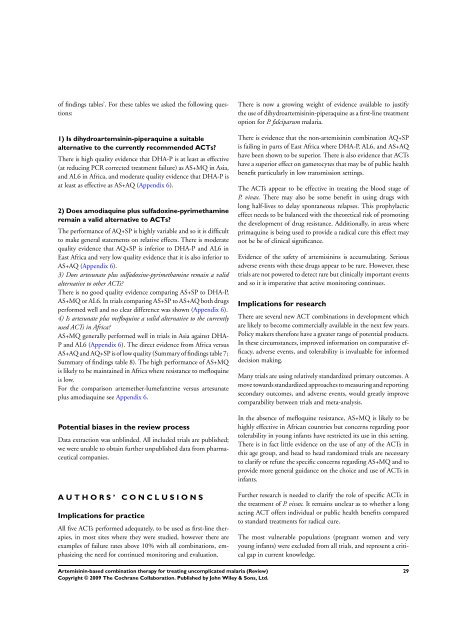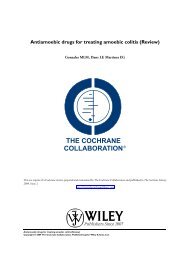Artemisinin-based combination therapy for ... - The Cochrane Library
Artemisinin-based combination therapy for ... - The Cochrane Library
Artemisinin-based combination therapy for ... - The Cochrane Library
You also want an ePaper? Increase the reach of your titles
YUMPU automatically turns print PDFs into web optimized ePapers that Google loves.
of findings tables’. For these tables we asked the following questions:<br />
1) Is dihydroartemsinin-piperaquine a suitable<br />
alternative to the currently recommended ACTs?<br />
<strong>The</strong>re is high quality evidence that DHA-P is at least as effective<br />
(at reducing PCR corrected treatment failure) as AS+MQ in Asia,<br />
and AL6 in Africa, and moderate quality evidence that DHA-P is<br />
at least as effective as AS+AQ (Appendix 6).<br />
2) Does amodiaquine plus sulfadoxine-pyrimethamine<br />
remain a valid alternative to ACTs?<br />
<strong>The</strong> per<strong>for</strong>mance of AQ+SP is highly variable and so it is difficult<br />
to make general statements on relative effects. <strong>The</strong>re is moderate<br />
quality evidence that AQ+SP is inferior to DHA-P and AL6 in<br />
East Africa and very low quality evidence that it is also inferior to<br />
AS+AQ (Appendix 6).<br />
3) Does artesunate plus sulfadoxine-pyrimethamine remain a valid<br />
alternative to other ACTs?<br />
<strong>The</strong>re is no good quality evidence comparing AS+SP to DHA-P,<br />
AS+MQ or AL6. In trials comparing AS+SP to AS+AQ both drugs<br />
per<strong>for</strong>med well and no clear difference was shown (Appendix 6).<br />
4) Is artesunate plus mefloquine a valid alternative to the currently<br />
used ACTs in Africa?<br />
AS+MQ generally per<strong>for</strong>med well in trials in Asia against DHA-<br />
P and AL6 (Appendix 6). <strong>The</strong> direct evidence from Africa versus<br />
AS+AQ and AQ+SP is of low quality (Summary of findings table 7;<br />
Summary of findings table 8). <strong>The</strong> high per<strong>for</strong>mance of AS+MQ<br />
is likely to be maintained in Africa where resistance to mefloquine<br />
is low.<br />
For the comparison artemether-lumefantrine versus artesunate<br />
plus amodiaquine see Appendix 6.<br />
Potential biases in the review process<br />
Data extraction was unblinded. All included trials are published;<br />
we were unable to obtain further unpublished data from pharmaceutical<br />
companies.<br />
A U T H O R S ’ C O N C L U S I O N S<br />
Implications <strong>for</strong> practice<br />
All five ACTs per<strong>for</strong>med adequately, to be used as first-line therapies,<br />
in most sites where they were studied, however there are<br />
examples of failure rates above 10% with all <strong>combination</strong>s, emphasizing<br />
the need <strong>for</strong> continued monitoring and evaluation.<br />
<strong>Artemisinin</strong>-<strong>based</strong> <strong>combination</strong> <strong>therapy</strong> <strong>for</strong> treating uncomplicated malaria (Review)<br />
Copyright © 2009 <strong>The</strong> <strong>Cochrane</strong> Collaboration. Published by John Wiley & Sons, Ltd.<br />
<strong>The</strong>re is now a growing weight of evidence available to justify<br />
the use of dihydroartemisinin-piperaquine as a first-line treatment<br />
option <strong>for</strong> P. falciparum malaria.<br />
<strong>The</strong>re is evidence that the non-artemisinin <strong>combination</strong> AQ+SP<br />
is failing in parts of East Africa where DHA-P, AL6, and AS+AQ<br />
have been shown to be superior. <strong>The</strong>re is also evidence that ACTs<br />
have a superior effect on gametocytes that may be of public health<br />
benefit particularly in low transmission settings.<br />
<strong>The</strong> ACTs appear to be effective in treating the blood stage of<br />
P. vivax. <strong>The</strong>re may also be some benefit in using drugs with<br />
long half-lives to delay spontaneous relapses. This prophylactic<br />
effect needs to be balanced with the theoretical risk of promoting<br />
the development of drug resistance. Additionally, in areas where<br />
primaquine is being used to provide a radical cure this effect may<br />
not be be of clinical significance.<br />
Evidence of the safety of artemisinins is accumulating. Serious<br />
adverse events with these drugs appear to be rare. However, these<br />
trials are not powered to detect rare but clinically important events<br />
and so it is imperative that active monitoring continues.<br />
Implications <strong>for</strong> research<br />
<strong>The</strong>re are several new ACT <strong>combination</strong>s in development which<br />
are likely to become commercially available in the next few years.<br />
Policy makers there<strong>for</strong>e have a greater range of potential products.<br />
In these circumstances, improved in<strong>for</strong>mation on comparative efficacy,<br />
adverse events, and tolerability is invaluable <strong>for</strong> in<strong>for</strong>med<br />
decision making.<br />
Many trials are using relatively standardized primary outcomes. A<br />
move towards standardized approaches to measuring and reporting<br />
secondary outcomes, and adverse events, would greatly improve<br />
comparability between trials and meta-analysis.<br />
In the absence of mefloquine resistance, AS+MQ is likely to be<br />
highly effective in African countries but concerns regarding poor<br />
tolerability in young infants have restricted its use in this setting.<br />
<strong>The</strong>re is in fact little evidence on the use of any of the ACTs in<br />
this age group, and head to head randomized trials are necessary<br />
to clarify or refute the specific concerns regarding AS+MQ and to<br />
provide more general guidance on the choice and use of ACTs in<br />
infants.<br />
Further research is needed to clarify the role of specific ACTs in<br />
the treatment of P. vivax. It remains unclear as to whether a long<br />
acting ACT offers individual or public health benefits compared<br />
to standard treatments <strong>for</strong> radical cure.<br />
<strong>The</strong> most vulnerable populations (pregnant women and very<br />
young infants) were excluded from all trials, and represent a critical<br />
gap in current knowledge.<br />
29








